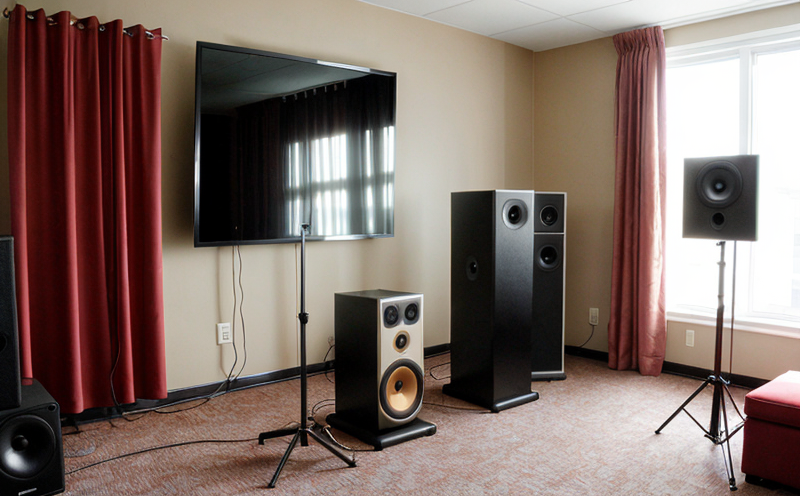ISO 1996-2 Assessment of Environmental Noise Perception
The ISO 1996-2 standard provides a method for assessing environmental noise perception. This is crucial in understanding how people perceive and react to environmental sounds, which can be used to evaluate the impact of noise on human health and well-being.
ISO 1996-2 defines an objective psychoacoustic model that estimates the perceived loudness of a sound based on its frequency content. This method is particularly useful in assessing the annoyance caused by environmental noises such as traffic, industrial noise, or construction activities. The standard is widely recognized and used globally to ensure consistent evaluation of these sounds.
The test procedure involves several steps:
- Recording the source sound using a suitable microphone
- Analyzing the frequency content of the recorded sound
- Evaluating the perceived loudness based on ISO 1996-2 criteria
- Comparing the results with established thresholds for annoyance and discomfort
This approach ensures that the noise is evaluated in a way that reflects how humans perceive it, rather than just its physical characteristics. This makes ISO 1996-2 a powerful tool for environmental noise assessment.
| Step | Description |
|---|---|
| Recording the Source Sound | The sound is recorded using a broadband microphone to capture all frequency components. |
| Analyzing Frequency Content | The recorded signal undergoes spectral analysis to determine its frequency content. |
| Evaluating Perceived Loudness | The perceived loudness is estimated using the ISO 1996-2 psychoacoustic model. |
| Comparing Results | The results are compared with established thresholds for annoyance and discomfort. |
Understanding how people perceive noise is essential for effective environmental noise management. ISO 1996-2 helps to ensure that the assessment of environmental noise is both accurate and consistent, allowing for better decision-making in urban planning, industrial design, and public health.
The standard's application spans various sectors including urban planning, transportation engineering, and occupational health. It provides a reliable method for assessing the impact of noise on human perception and well-being. This makes ISO 1996-2 an indispensable tool for quality managers, compliance officers, R&D engineers, and procurement teams in these fields.
Industry Applications
The ISO 1996-2 method finds extensive use across various industries where environmental noise is a significant concern. Here are some key applications:
- Urban Planning: Evaluating the impact of new developments on local noise levels.
- Airports and Aviation: Assessing the noise generated by aircraft operations for compliance with regulations.
- Railways: Monitoring noise emissions to ensure they are within acceptable limits.
- Manufacturing: Evaluating the noise levels in factories to protect workers' hearing.
- Construction: Assessing construction noise during operational hours to minimize disruption.
The standard's versatility allows for a comprehensive approach to noise management, ensuring that all aspects of environmental noise are accounted for. This holistic view is crucial for effective noise control and mitigation strategies.
International Acceptance and Recognition
ISO 1996-2 enjoys widespread international acceptance and recognition:
- The standard is endorsed by the International Organization for Standardization (ISO).
- It is recognized globally as a benchmark for assessing environmental noise perception.
- Many countries have adopted it into their national standards or regulations.
- It is used in both public and private sectors to ensure compliance with international best practices.
The standard's acceptance reflects its reliability and consistency, making it an ideal tool for cross-border evaluations of environmental noise. Its use across different regions ensures that the same criteria are applied globally, enhancing comparability and effectiveness.
Use Cases and Application Examples
The ISO 1996-2 method is used in a variety of scenarios:
- Urban Noise Surveys: Assessing noise levels around urban areas to identify hotspots.
- Airport Expansion Projects: Evaluating the impact of increased aircraft operations on surrounding communities.
- Railway Development Plans: Monitoring noise emissions during construction phases.
- Factory Audits: Assessing the noise levels in manufacturing environments to ensure compliance with health and safety regulations.
- Construction Site Evaluations: Ensuring that noise levels are kept within acceptable limits during operational hours.
In these scenarios, ISO 1996-2 provides a standardized approach to evaluating environmental noise, allowing for consistent and reliable results. This ensures that all parties involved in the project can make informed decisions based on accurate data.





